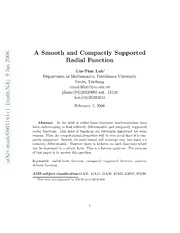
A Smooth and Compactly Supported Radial Function PDF
Preview A Smooth and Compactly Supported Radial Function
A Smooth and Compactly Supported 6 0 0 Radial Function 2 n a J Lin-Tian Luh ∗ 9 Department of Mathematics, Providence University ] Shalu, Taichung A N email:[email protected] . phone:(04)26328001 ext. 15126 h t a fax:(04)26324653 m [ February 2, 2008 1 v 1 6 1 Abstract. In the field of radial basis functions mathematicians have 1 0 been endeavouring to find infinitely differentiable and compactly supported 6 radial functions. This kind of functions are extremely important for some 0 / reasons. First, its computational properties will be very good since it’s com- h t pactly supported. Second, its error bound will converge very fast since it’s a m infinitely differentiable. However there is hitherto no such functions which can be expressed in a simple form. This is a famous question. The purpose : v of this paper is to answer this question. i X r a keywords: radial basis function, compactly supported function, positive definite function. AMS subject classification:41A05, 41A15, 41A30, 41A63, 65D07, 65D10. ∗This work was supported by NSC93-2115-M126-004. 1 1 Introduction In this paper we raise a new function −α e1−kxk2 if x < 1 Φ(x) := (1) k k ( 0 if x 1 k k ≥ where α > 0 is a constant and x denotes the Euclidean norm of x Rn. k k ∈ The infinite differentiability of Φ can be shown by routine investigation, and we omit it. What’s difficult is to show its positive definiteness. In order to make it useful in scattered data interpolation, this problem has to be overcome. This is the main theme of the next section. 2 Positive Definiteness It’s well known that positive definiteness is just conditional positive definite- ness of order zero. Here we adopt the definition of [1] for conditional positive definiteness. Before showing that the map defined in (1) is positive definite, let’s define −α φ(t) := e1−t2 if 0 ≤ t < 1 (2) ( 0 if 1 t. ≤ where α > 0 is a constant. In other words, φ( x ) = Φ(x) for x Rn. In k k ∈ order to make this paper easier to understand, let’s analyze the derivatives of φ(√t) of order up to eight. It’s easily seen that with u = 1 , we have du = u2 for u > 1 and 1−t dt dφ(√t) = e−αu( α)u2 • dt − d2 φ(√t) = e−αu[α2u4 2αu3] • dt2 − d3 φ(√t) = e−αu[ α3u6 +6α2u5 6αu4] • dt3 − − d4 φ(√t) = e−αu[α4u8 12α3u7 +36α2u6 24αu5] • dt4 − − d5 φ(√t) = e−αu[ α5u10 +20α4u9 120α3u8 +240α2u7 120αu6] • dt5 − − − d6 φ(√t) = e−αu[α6u12 30α5u11+300α4u10 1200α3u9+1800α2u8 • dt6 − − − 720αu7] 2 d7 = e−αu[ α7u14 +42α6u13 630α5u12 +4200α4u11 12600α3u10 + • dt7 − − − 15120α2u9 5040αu8] − d8 φ(√t) = e−αu[α8u16 56α7u15+1176α6u14 11760α5u13+58800α4u12 • dt8 − − − 141120α3u11 +141120α2u10 40320αu9]. − By induction, for j 1, ≥ dj dtjφ(√t) = e−αu[(−1)jαju2j +(−1)j−1aj−1αj−1u2j−1+···+(−1)a1αuj+1] where a1, ,aj−1 are nonnegative integers. Obviously ··· dj ( 1)j φ(√t) 0 − dtj ≥ for all j 1 and u 1(i.e. 0 t < 1) as long as α is large enough. In fact ≥ ≥ ≤ we have the following more accurate lemma. Lemma 2.1 Assume that α = 0 and α = α + 2j for j = 1,2,3, . 1 j+1 j ··· Then for any j 1, ≥ dj ( 1)j φ(√t) 0 − dtj ≥ for all t > 0 if α α . j ≥ Proof. Note thatif α is defined asinthe lemma, then α is just theexponent j j of u in the first term of dj−1 φ(√t) plus the absolute value of the integer dtj−1 coefficient in the second term of dj−1 φ(√t). In turn the absolute value of the dtj−1 integer coefficient in the second term of dj−1 φ(√t) is the exponent of u in dtj−1 the first term of dj−2 φ(√t) plus the absolute value of the integer coefficient dtj−2 in the second term of dj−2 φ(√t). Our lemma thus follows immediately by dtj−2 simple induction. Theorem 2.2 (a)Suppose α 12. Then Φ(x) in (1) is positive definite on Rd for 1 d 4. (b)Suppose≥n > 4 and α α for j = n−4 +4, where ≤ ≤ ≥ j ⌈ 2 ⌉ λ denotes the least integer not less than λ. Then Φ(x) in (1) is positive ⌈ ⌉ definite on Rd for 1 d n. ≤ ≤ Proof. This is an immediate result of Theorem1 of [1], Theorem2.2 of [2] and Lemma2.1 of this paper. 3 Remark: In this theorem we treat Rd for 1 d 4 independently to ≤ ≤ make it easy for use. In fact, if we require Φ be positive definite on Rd for 1 d 2 only, then α 6 is sufficient. The first values of α are j ≤ ≤ ≥ 0,2,6,12,20,30,42,56,72,90, ; for j = 1,2,3,4,5,6,7,8,9,10, , respec- tively. It’s easily seen from ou·r·d·eduction of dj φ(√t) that ··· dtj dj ( 1)j φ(√t) 0 − dtj ≥ for j = 1,2, ,8 if α α , and t > 0. Thus we already checked that Φ(x) j ··· ≥ is positive definite on Rd for 1 d 12 if α 56. For higher dimensions, ≤ ≤ ≥ the values of the necessary α can be calculated recursively. It’s a bit more j tedious, but very easy. References [1] N. Dyn, Interpolation and Approximation by Radial and Related Func- tions, Approximation Theory VI, (C.K. Chui, L.L. Schumaker and J. Ward eds.), Academic Press,(1989),211-234. [2] C.A. Micchelli, Interpolation of Scattered Data:Distance Matrices and Conditionally Positive Definite Functions, Constr. Approx. 2(1986),11- 22. 4
